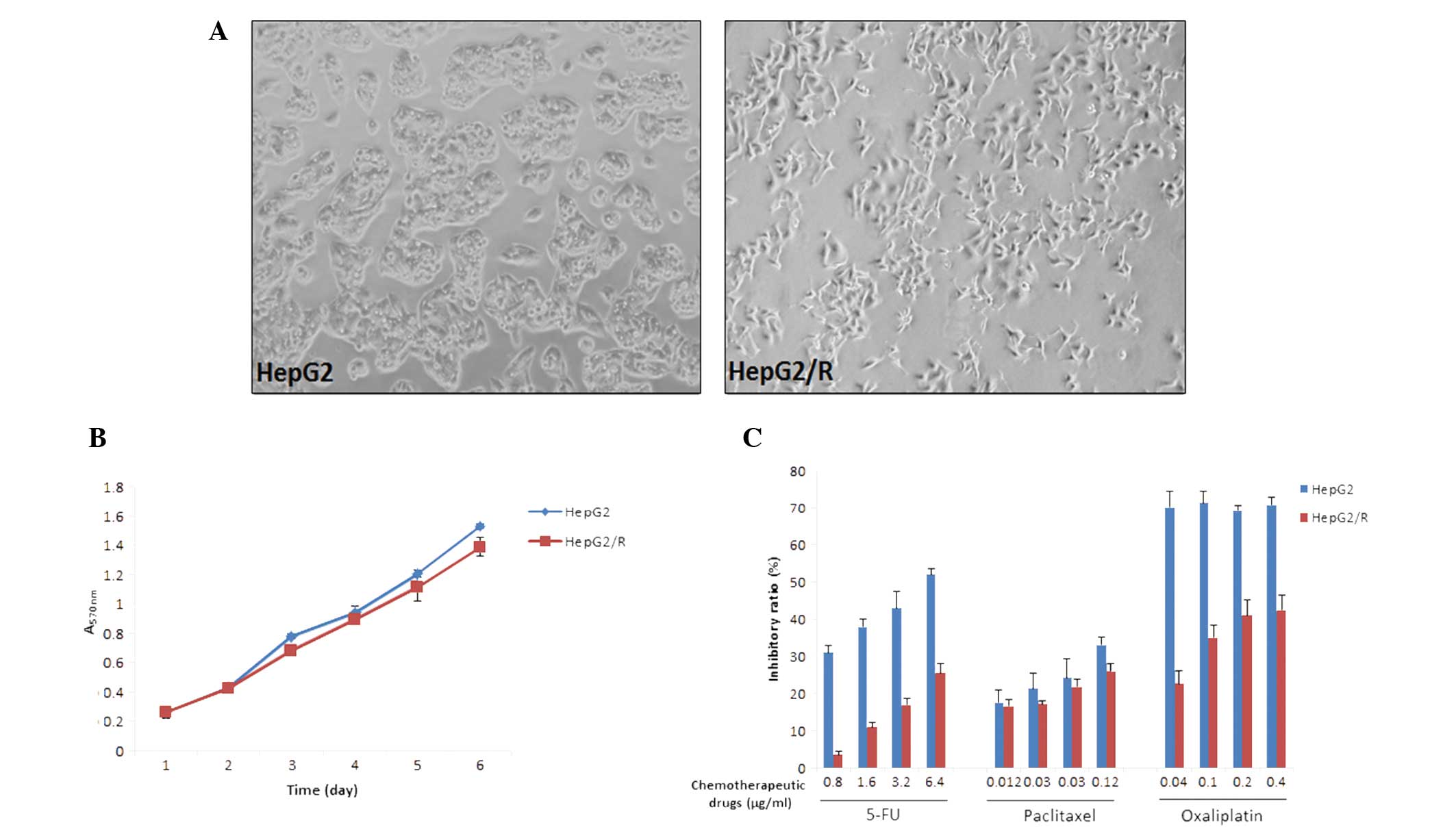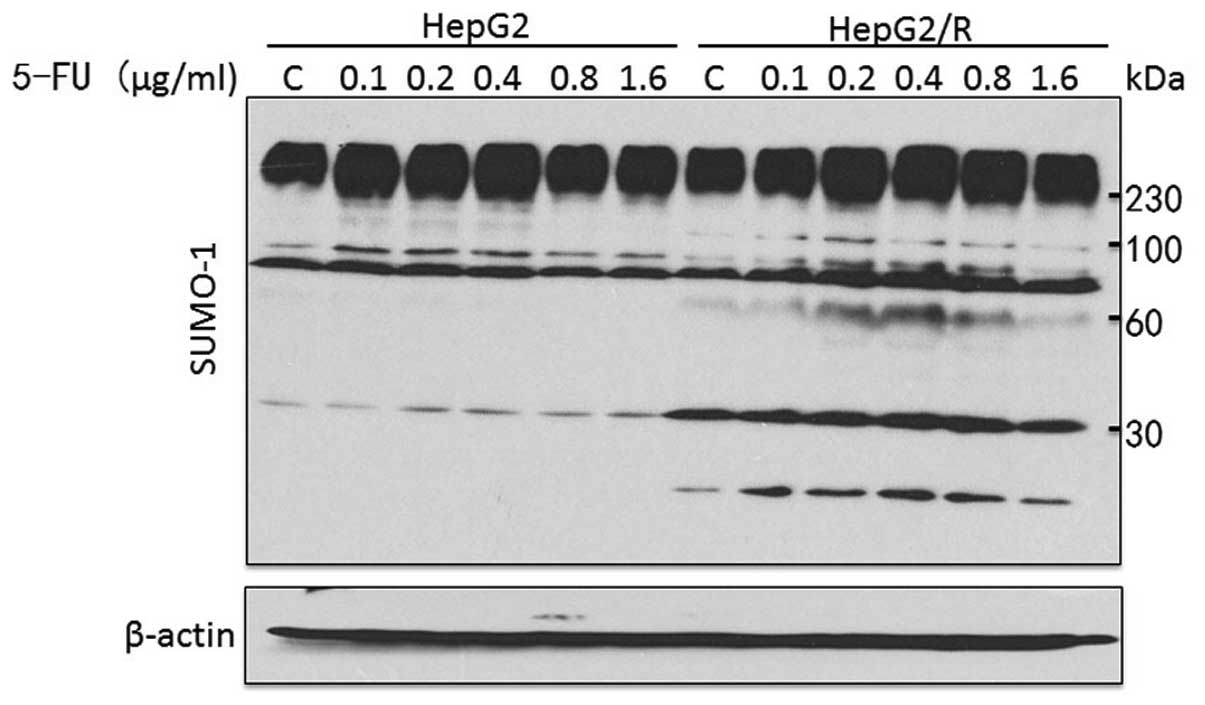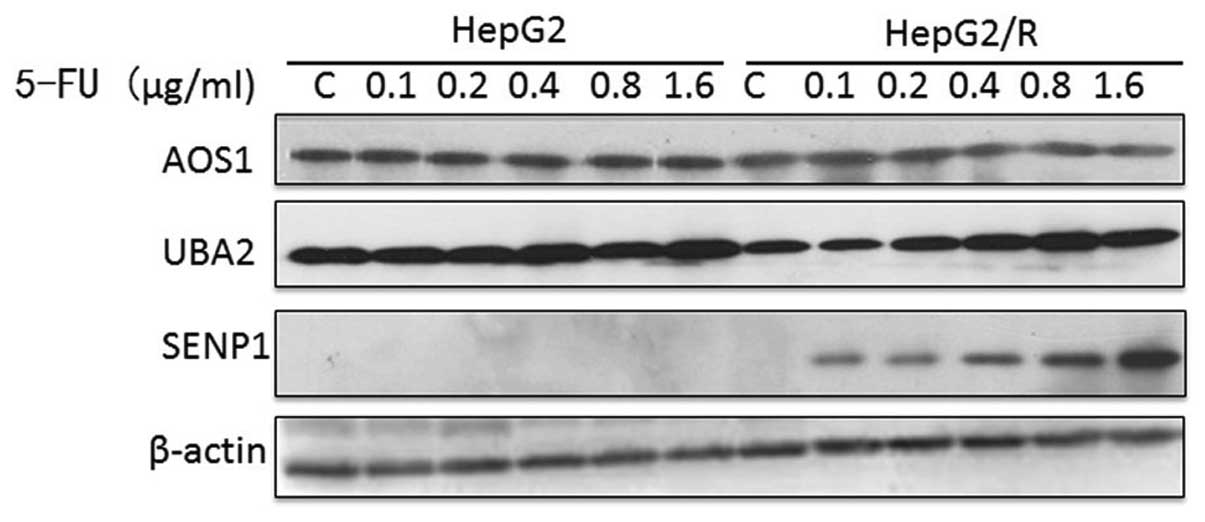SUMOylation alterations are associated with multidrug resistance in hepatocellular carcinoma
- Authors:
- Published online on: January 2, 2014 https://doi.org/10.3892/mmr.2014.1882
- Pages: 877-881
Abstract
Introduction
Small ubiquitin-like modifier (SUMO)ylation is a post-translational modification that involves the covalent, but reversible, binding of SUMO (1). Four isoforms of SUMO have been identified, SUMO-1, -2, -3 and -4. These proteins are ~12 kDa in size and are structurally similar to ubiquitin (2–5). Similar to ubiquitination, the SUMOylation cascade contains a SUMO-activating enzyme (E1), a SUMO-conjugating enzyme (E2) and different SUMO ligases (E3s). All SUMO isoforms are expressed as immature precursors with a variable C-terminus comprising 2–11 residues, following an essential GG motif. Maturation of SUMO involves the removal of this C-terminal tail by sentrin-specific proteases (SENPs) and exposing the diglycine motif required for conjugation. SUMO is then activated in an ATP-dependent manner by conjugation to the E1 heterodimer, activator of SUMO-1 (Aos1) and ubiquitin-like modifier activating enzyme 2 (Uba2). Activated SUMO is then transferred to the unique E2 enzyme Ubc9, which covalently attaches the modifier to the ɛ-amino group of a target lysine residue in the presence of an E3 SUMO ligase (1,6,7). Cleavage after the diglycine motif by SENPs then removes the conjugated SUMO moieties from the target protein.
Due to its regulation of protein activity, post-translational modifications may have profound effects on carcinogenesis. SUMOylation has been shown to regulate various cellular pathways, including DNA replication and repair, chromosome packing and dynamics, genome integrity, nuclear transport, signal transduction and cell proliferation. These functions suggest that abnormal SUMOylation may affect cancer progression and metastasis (8–15).
Hepatocellular carcinoma (HCC) is the sixth most common type of malignancy worldwide. It is the fifth most common type of malignant disease in males, the eighth most common type of malignant disease in females and the third most common cause of cancer-related mortality following lung and stomach cancer (16). Systemic chemotherapy represents a palliative treatment following resection and/or transplant surgery for inoperable patients. However, intrinsic or acquired multidrug resistance (MDR) may interfere with the efficacy of chemotherapy in HCC. MDR, which results in increased drug efflux from cells, is associated with increased DNA repair and drug metabolism, as well as decreased apoptosis, all of which affect the tumor microenvironment (17–20). However, the role of SUMOylation in MDR or chemotherapy remains largely unknown.
The aim of this study was to analyze the resistance mechanisms of HCC. A novel multidrug resistant-HCC cell line (HepG2/R) was developed based on HepG2 cells, a model for chemosensitive HCC cells. We investigated the levels of SUMOylation in these cells and analyzed the specific role in the development of drug resistance in HCC cells.
Materials and methods
Chemotherapeutic drugs and antibodies
The chemotherapeutic drugs 5-fluorouracil (5-FU, catalog no. F6627-1G), paclitaxel (catalog no. O9512-5MG) and oxaliplatin (catalog no. O9512-5MG) were purchased from Sigma-Aldrich (St. Louis, MO, USA). Mouse antibodies against SUMO-1 (catalog no. sc-5308), Aos1 (catalog no. sc-271592), Uba2 (catalog no. sc-136359) and SENP1 (catalog no. sc-271360) were purchased from Santa Cruz Biotechnology, Inc. (Santa Cruz, CA, USA).
Cell lines
The HepG2 human HCC cell line was provided by Dr H Tang (Tianjin Life Science Research Center and Basic Medical School, Tianjin Medical University, Tianjin, China). The MDR sub-line HepG2/R was established by culturing HepG2 cells in the presence of increasing concentrations of 5-FU (0.1, 0.2, 0.4, 0.8 and 1.6 μg/ml). HepG2/R cells were cultured in the presence of 1.6 μg/ml (12.3 mM) 5-FU to maintain their phenotype. All cells were cultured in Dulbecco’s modified Eagle’s medium supplemented with 10% fetal bovine serum, 100 μg/ml penicillin and 100 μg/ml streptomycin at 37°C in 5% CO2.
Human samples
Samples of paraffin-embedded HCC tissues and their adjacent non-neoplastic controls (n=20) were obtained from patients who underwent surgical resection at the Department of Hepatobiliary Surgery, Tianjin Medical University Cancer Institute and Hospital. HCC in these samples was confirmed by pathological diagnosis. This study was approved by the Committee for the Protection of Human Subjects of Tianjin Medical University Cancer Institute and Hospital and informed consent was obtained from all patients.
Immunohistochemical analysis
The expression of SUMO-1 was demonstrated by immunohistochemistry (IHC) according to the manufacturer’s instructions (pv-6000; ZSGB-BIO, Beijing, China). Sections (4μm-thick) were deparaffinized in xylene and endogenous peroxidase activity was blocked with 3% hydrogen peroxide in 50% methanol for 10 min at room temperature. The slides were rehydrated in a series of alcohol washes, and washed with phosphate-buffered saline (PBS) and pretreated with citrate buffer for 20 min at 95°C. Following blocking of nonspecific binding sites with 10% normal goat serum in PBS for 20 min at 37°C, the sections were incubated overnight at 4°C with anti-SUMO-1 (dilution, 1:200). Sections were rinsed with PBS and incubated with HRP-goat anti-mouse immunoglobulin G (IgG) for 20 min at 37°C. Subsequently, the slides were incubated with 3,3′-diaminobenzidine chromogen for 5–10 min at room temperature and washed with distilled water. Finally, sections were counterstained with hematoxylin for 1 min, dehydrated and mounted on coverslips. PBS without the primary antibody was used as a negative control.
Western blot analysis
Protein lysate was separated by SDS-PAGE and transferred onto polyvinylidene fluoride membranes (GE Healthcare, Piscataway, NJ, USA). Membranes were blocked in TBST (50 mM Tris pH 7.5, 0.15 M sodium chloride, 0.5% Tween-20) containing 5% non-fat milk. Immunoblotting was performed using indicated antibodies diluted in TBST. The membranes were washed and incubated with goat anti-mouse IgG-horseradish peroxidase conjugate (Bio-Rad, Hercules, CA, USA). Specific complexes were visualized using an enhanced chemiluminescence detection system (GE Healthcare, Little Chalfont, UK).
3-(4,5-dimethylthiahiazol-2-yl)-2,5-diphenyl tetrazolium bromide (MTT) assay
MTT assays were used to evaluate rates of cell growth (Cell Growth Determination kit; Sigma-Aldrich, catalog no. CGD1). Cells were trypsinized into a single-cell suspension and seeded into 96-well plates at a density of 1×103 cells/well. At the indicated time points, 10% of the culture volume (20 μl) MTT was added to each well and incubated for 4 h at 37°C. Cultures were removed from the incubator and the resultant MTT formazan crystals were dissolved in 180 μl MTT solvent (0.1 N HCl in anhydrous isopropanol). Absorbance values were measured using a microplate absorbance reader (Bio-Rad Laboratories, Richmond, CA, USA) at a wavelength of 570 nm. To measure the effect of the chemotherapeutic agents on growth, the inhibitory rate was calculated as follows: Cell growth inhibition (%) = [A570(control) − A570(experiment)]/A570(control) × 100.
Statistical analysis
All experiments were performed at least in triplicate. Statistical significance was evaluated using Student’s t-test. P<0.05 was considered to indicate a statistically significant difference.
Results
Establishment and characterization of the HCC MDR cell line HepG2/R
To obtain multidrug resistant-cells, HepG2 cells were treated with increasing concentrations of 5-FU between 0.1 and 1.6 μg/ml. The drug-resistant subclone HepG2/R was established almost one year following initiation of treatment. HepG2/R cells were morphologically distinct from their parental cell line in that they demonstrated increased pseudopodia formation (Fig. 1A). Cell proliferation did not differ significantly between the HepG2 and HepG2/R cells (Fig. 1B). Next, the sensitivity of the two cell lines to specific concentrations of chemotherapeutic drugs was investigated. Following treatment with 0.8–6.4 μg/ml 5-FU, the inhibitory ratios of HepG2/R were markedly lower compared with those of the parental HepG2 cells (Fig. 1C). The cross-resistance to other chemotherapeutic drugs, including paclitaxel and oxaliplatin was also investigated. HepG2/R cells were observed to develop cross-resistance to paclitaxel and oxaliplatin to varying degrees (Fig. 1C).
SUMO-1 is overexpressed in clinical HCC samples
Immunostaining was used to evaluate the SUMO-1 expression in tumor cells from HCC tissues and normal cells from the adjacent non-neoplastic liver tissue. Nuclear SUMO-1 expression was detected in HCC neoplastic cells from all samples (100%). However, in the matched non-neoplastic controls, little or no SUMO-1 expression was observed (Fig. 2A and B).
SUMO-1-conjugated proteins differ between HepG2 and HepG2/R cells
To investigate the pattern of SUMOylation in HepG2 and HepG2/R cells treated with 5-FU at different concentrations, whole-cell lysates were probed with a SUMO-1 antibody. The total levels of SUMOylation were significantly enhanced in HepG2/R cells. As shown in Fig. 3, distinct SUMO-1-conjugated and free SUMO-1 proteins were detected in HepG2/R cells at ~60 and 12 kDa, respectively. The levels of SUMO-1-conjugated proteins at 30 and 100 kDa were also markedly increased.
Uba2 and SENP1 are upregulated in the HepG2/R cell line
In addition, the levels of SUMOylation enzymes in the HepG2 and HepG2/R cells were compared to determine whether the SUMOylation pathway differed. Although Aos1 levels were unaffected by the 5-FU treatment, Uba2 and SENP1 levels increased in a dose-dependent manner in HepG2/R cells (Fig. 4).
Discussion
Drug resistance is a major obstacle for the successful chemotherapeutic treatment of HCC. Often following chemotherapy, tumors fail to reduce in size or the cancer recurs following an initial response. MDR is particularly problematic as it involves the simultaneous resistance to numerous chemotherapeutic drugs of different classes. However, the mechanism of MDR remains unclear. To elucidate the molecular mechanisms in HCC a multidrug-resistant cell model is required. 5-FU has been used alone or in combination with other chemotherapeutic drugs for HCC and other malignant tumors (21,22). Thus, an MDR HCC cell line, HepG2/R, was established by exposing HepG2 cells to increasing concentrations of 5-FU over one year. HepG2/R cells exhibited a strong resistance to 5-FU and also demonstrated cross-resistance to multiple, structurally diverse chemotherapeutic agents, including paclitaxel and oxaliplatin.
SUMOylation is essential for the maintenance of protein stability, transcriptional regulation and modification of particular transcription factors. SUMOylation is also involved in cellular processes, including mitosis, differentiation, senescence and apoptosis (8,23–26). Guo et al (27) reported that SUMO-1 was overexpressed in all HCC cell lines and clinical HCC samples that were tested. In agreement with this observation, the current study showed an increase in the expression of SUMO-1 in clinical HCC samples compared with the adjacent non-neoplastic liver tissue controls. This suggests that SUMOylation may be important in HCC. In addition, total levels of SUMO-1-conjugated proteins are increased in HepG2/R cells compared with parental HepG2 cells. This demonstrates that higher levels of SUMOylation are associated with MDR in HCC, possibly by affecting pathways that induce MDR.
SUMOylation is a dynamic process involving the conjugation (Aos1/Uba2, Ubc9 and different E3 ligases) and de-conjugation machinery (SENPs) (1). Notably, these enzymes have also been observed to affect tumorigenesis. Inactivation of Uba2 leads to mitotic catastrophe and cell death following Myc hyperactivation. Uba2 inhibition switches a transcriptional subprogram of Myc from activated to repressed (28). SENP1 is highly expressed in prostate cancer and correlates with hypoxia-inducing factor 1 (HIF-1) expression, which is associated with an increase in P-glycoprotein expression and the occurrence of MDR in tumor cells (29,30). In the current study, high concentrations of 5-FU were found to increase Uba2 expression in HCC MDR cells. This increase may affect cellular processes regulated by oncogenic Myc. 5-FU treatment also increased SENP1 expression in a dose-dependent manner, potentially implicating HIF-1 in the development of MDR in HCC.
In conclusion, the development of MDR in HCC was observed to be associated with increased SUMOylation, likely due to the increased expression of Uba2 and SENP1. These results suggest that the SUMOylation pathway may be a novel therapeutic target for preventing the development of MDR in HCC, thus, increasing the efficacy of chemotherapy for this widespread disease.
Acknowledgements
This study was supported by scientific research grants from Tianjin Medical University (grant nos. 2010ky04 and 2011ky42).
Abbreviations:
|
Aos1 |
activator of SUMO-1 |
|
HCC |
hepatocellular carcinoma |
|
MDR |
multidrug resistance |
|
SENP1 |
sentrin-specific protease 1 |
|
SUMO |
small ubiquitin-like modifier |
|
Uba2 |
ubiquitin-like modifier activating enzyme 2 |
References
|
Geiss-Friedlander R and Melchior F: Concepts in sumoylation: a decade on. Nat Rev Mol Cell Biol. 8:947–956. 2007. View Article : Google Scholar : PubMed/NCBI | |
|
Meluh PB and Koshland D: Evidence that the MIF2 gene of Saccharomyces cerevisiae encodes a centromere protein with homology to the mammalian centromere protein CENP-C. Mol Biol Cell. 6:793–807. 1995.PubMed/NCBI | |
|
Shen Z, Pardington-Purtymun PE, Comeaux JC, Moyzis RK and Chen DJ: UBL1, a human ubiquitin-like protein associating with human RAD51/RAD52 proteins. Genomics. 36:271–279. 1996. View Article : Google Scholar : PubMed/NCBI | |
|
Okura T, Gong L, Kamitani T, Wada T, Okura I, Wei CF, Chang HM and Yeh ET: Protection against Fas/APO-1- and tumor necrosis factor-mediated cell death by a novel protein, sentrin. J Immunol. 157:4277–4281. 1996.PubMed/NCBI | |
|
Seeler JS and Dejean A: Nuclear and unclear functions of SUMO. Nat Rev Mol Cell Biol. 4:690–699. 2003. View Article : Google Scholar : PubMed/NCBI | |
|
Wadosky KM and Willis MS: The story so far: post-translational regulation of peroxisome proliferator-activated receptors by ubiquitination and SUMOylation. Am J Physiol Heart Circ Physiol. 302:H515–H526. 2012. View Article : Google Scholar : PubMed/NCBI | |
|
Gong L, Li B, Millas S and Yeh ET: Molecular cloning and characterization of human AOS1 and UBA2, components of the sentrin-activating enzyme complex. FEBS Lett. 448:185–189. 1999. View Article : Google Scholar : PubMed/NCBI | |
|
Muller S, Berger M, Lehembre F, Seeler JS, Haupt Y and Dejean A: c-Jun and p53 activity is modulated by SUMO-1 modification. J Biol Chem. 275:13321–13329. 2000. View Article : Google Scholar : PubMed/NCBI | |
|
Liu G and Warbrick E: The p66 and p12 subunits of DNA polymerase delta are modified by ubiquitin and ubiquitin-like proteins. Biochem Biophys Res Commun. 349:360–366. 2006. View Article : Google Scholar : PubMed/NCBI | |
|
Tanaka K, Nishide J, Okazaki K, Kato H, Niwa O, Nakagawa T, Matsuda H, Kawamukai M and Murakami Y: Characterization of a fission yeast SUMO-1 homologue, pmt3p, required for multiple nuclear events, including the control of telomere length and chromosome segregation. Mol Cell Biol. 19:8660–8672. 1999.PubMed/NCBI | |
|
Bachant J, Alcasabas A, Blat Y, Kleckner N and Elledge SJ: The SUMO-1 isopeptidase Smt4 is linked to centromeric cohesion through SUMO-1 modification of DNA topoisomerase II. Mol Cell. 9:1169–1182. 2002. View Article : Google Scholar : PubMed/NCBI | |
|
Azuma Y, Arnaoutov A and Dasso M: SUMO-2/3 regulates topoisomerase II in mitosis. J Cell Biol. 163:477–487. 2003. View Article : Google Scholar : PubMed/NCBI | |
|
Wu N, Kong X, Ji Z, Zeng W, Potts PR, Yokomori K and Yu H: Scc1 sumoylation by Mms21 promotes sister chromatid recombination through counteracting Wapl. Genes Dev. 26:1473–1485. 2012. View Article : Google Scholar : PubMed/NCBI | |
|
McAleenan A, Cordon-Preciado V, Clemente-Blanco A, Liu IC, Sen N, Leonard J, Jarmuz A and Aragón L: SUMOylation of the α-kleisin subunit of cohesin is required for DNA damage-induced cohesion. Curr Biol. 22:1564–1575. 2012. | |
|
Luo K, Zhang H, Wang L, Yuan J and Lou Z: Sumoylation of MDC1 is important for proper DNA damage response. EMBO J. 31:3008–3019. 2012. View Article : Google Scholar : PubMed/NCBI | |
|
Ferenci P, Fried M, Labrecque D, Bruix J, Sherman M, Omata M, Heathcote J, Piratsivuth T, Kew M, Otegbayo JA, et al: Hepatocellular carcinoma (HCC): a global perspective. J Clin Gastroenterol. 44:239–245. 2010. View Article : Google Scholar : PubMed/NCBI | |
|
Correia AL and Bissell MJ: The tumor microenvironment is a dominant force in multidrug resistance. Drug Resist Updat. 15:39–49. 2012. View Article : Google Scholar : PubMed/NCBI | |
|
Doublier S, Belisario DC, Polimeni M, Annaratone L, Riganti C, Allia E, Ghigo D, Bosia A and Sapino A: HIF-1 activation induces doxorubicin resistance in MCF7 3-D spheroids via P-glycoprotein expression: a potential model of the chemo-resistance of invasive micropapillary carcinoma of the breast. BMC Cancer. 12:42012. View Article : Google Scholar | |
|
Brökers N, Le-Huu S, Vogel S, Hagos Y, Katschinski DM and Kleinschmidt M: Increased chemoresistance induced by inhibition of HIF-prolyl-hydroxylase domain enzymes. Cancer Sci. 101:129–136. 2010.PubMed/NCBI | |
|
Fabregat I, Roncero C and Fernández M: Survival and apoptosis: a dysregulated balance in liver cancer. Liver Int. 27:155–162. 2007. View Article : Google Scholar : PubMed/NCBI | |
|
Homann N, Pauligk C, Luley K, et al: Pathological complete remission in patients with oesophagogastric cancer receiving preoperative 5-fluorouracil, oxaliplatin and docetaxel. Int J Cancer. 130:1706–1713. 2012. View Article : Google Scholar | |
|
Kitagawa K, Kawada K, Morita S, et al: Prospective evaluation of corrected QT intervals and arrhythmias after exposure to epirubicin, cyclophosphamide, and 5-fluorouracil in women with breast cancer. Ann Oncol. 23:743–747. 2012. View Article : Google Scholar | |
|
Nagai S, Davoodi N and Gasser SM: Nuclear organization in genome stability: SUMO connections. Cell Res. 21:474–485. 2011. View Article : Google Scholar : PubMed/NCBI | |
|
Cai Q and Robertson ES: Ubiquitin/SUMO modification regulates VHL protein stability and nucleocytoplasmic localization. PLoS One. 5:e126362010. View Article : Google Scholar : PubMed/NCBI | |
|
Ding B, Sun Y and Huang J: Overexpression of SKI oncoprotein leads to p53 degradation through regulation of MDM2 protein sumoylation. J Biol Chem. 287:14621–14630. 2012. View Article : Google Scholar : PubMed/NCBI | |
|
Bettermann K, Benesch M, Weis S and Haybaeck J: SUMOylation in carcinogenesis. Cancer Lett. 316:113–125. 2012. View Article : Google Scholar : PubMed/NCBI | |
|
Guo WH, Yuan LH, Xiao ZH, Liu D and Zhang JX: Overexpression of SUMO-1 in hepatocellular carcinoma: a latent target for diagnosis and therapy of hepatoma. J Cancer Res Clin Oncol. 137:533–541. 2011. View Article : Google Scholar : PubMed/NCBI | |
|
Kessler JD, Kahle KT, Sun T, et al: A SUMOylation-dependent transcriptional subprogram is required for Myc-driven tumorigenesis. Science. 335:348–353. 2012. View Article : Google Scholar : PubMed/NCBI | |
|
Wang Q, Xia N, Li T, et al: SUMO-specific protease 1 promotes prostate cancer progression and metastasis. Oncogene. 32:2493–2498. 2013. View Article : Google Scholar : PubMed/NCBI | |
|
Wartenberg M, Ling FC, Muschen M, et al: Regulation of the multidrug resistance transporter P-glycoprotein in multicellular tumor spheroids by hypoxia-inducible factor (HIF-1) and reactive oxygen species. FASEB J. 17:503–505. 2003. |













